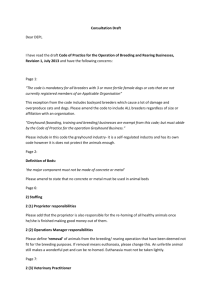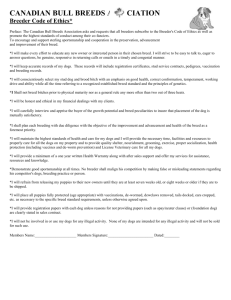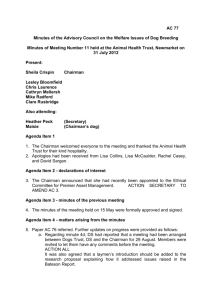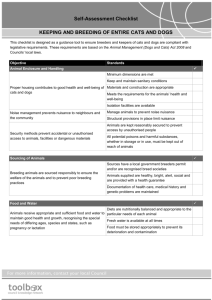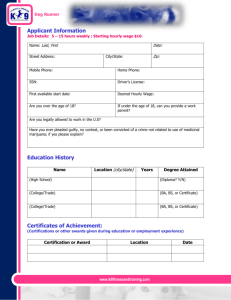Minutes of council meeting 30 nov 31211 final
advertisement
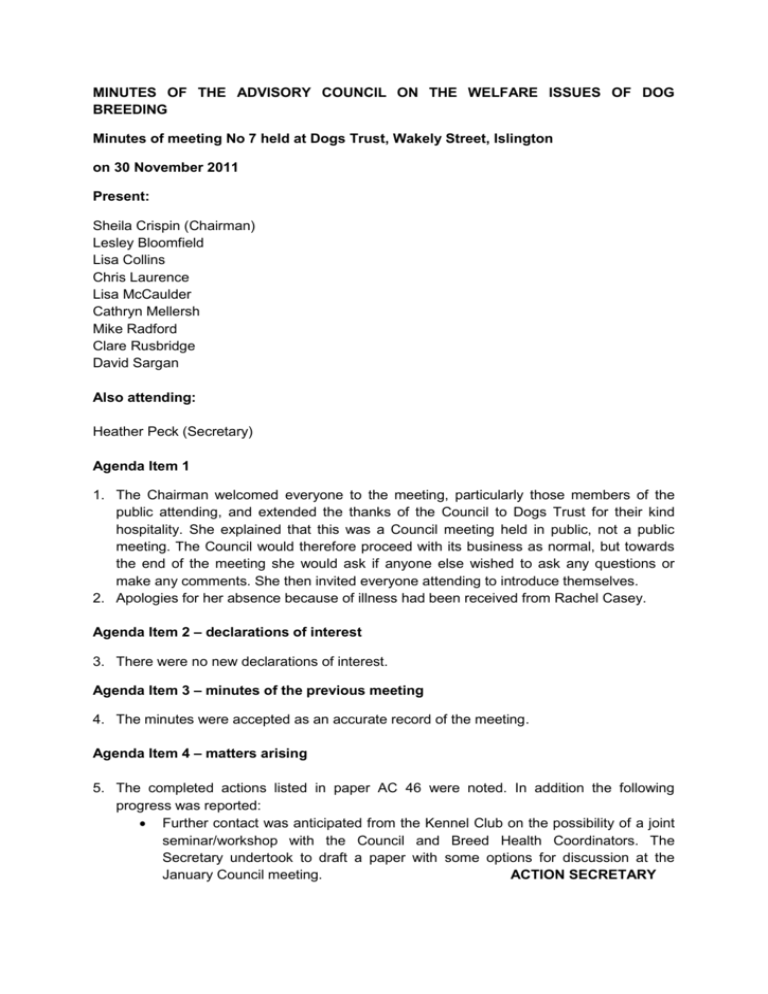
MINUTES OF THE ADVISORY COUNCIL ON THE WELFARE ISSUES OF DOG BREEDING Minutes of meeting No 7 held at Dogs Trust, Wakely Street, Islington on 30 November 2011 Present: Sheila Crispin (Chairman) Lesley Bloomfield Lisa Collins Chris Laurence Lisa McCaulder Cathryn Mellersh Mike Radford Clare Rusbridge David Sargan Also attending: Heather Peck (Secretary) Agenda Item 1 1. The Chairman welcomed everyone to the meeting, particularly those members of the public attending, and extended the thanks of the Council to Dogs Trust for their kind hospitality. She explained that this was a Council meeting held in public, not a public meeting. The Council would therefore proceed with its business as normal, but towards the end of the meeting she would ask if anyone else wished to ask any questions or make any comments. She then invited everyone attending to introduce themselves. 2. Apologies for her absence because of illness had been received from Rachel Casey. Agenda Item 2 – declarations of interest 3. There were no new declarations of interest. Agenda Item 3 – minutes of the previous meeting 4. The minutes were accepted as an accurate record of the meeting. Agenda Item 4 – matters arising 5. The completed actions listed in paper AC 46 were noted. In addition the following progress was reported: Further contact was anticipated from the Kennel Club on the possibility of a joint seminar/workshop with the Council and Breed Health Coordinators. The Secretary undertook to draft a paper with some options for discussion at the January Council meeting. ACTION SECRETARY It was noted that the Council had had a discussion of the principles which might underpin any proposals relating to reform of, or new, legislation and this would be reported and taken further under Agenda Item 6. Agenda Item 5 – Chairman’s Report 6. The Chairman’s report was taken as read. In a brief discussion of the issue of how to communicate the welfare impact of eye defects to breeders, it was noted that both primary inherited conditions and those arising from extremes of conformation were being addressed, but required different approaches. Agenda Item 6 – Progress Reports 7. Report on Project 1 – guidance on purchasing a dog: It was explained that the Council had begun by drafting the necessary text and this had now been translated into a first draft of working web pages. DS demonstrated progress to date and explained that the pages led the enquirer through the issues of choosing the right dog, finding a trustworthy breeder, and what to ask or look for in the breeder. If the answers to questions put to the breeder were unsatisfactory, such as a refusal to let the potential purchaser see the puppy with its dam, the website would steer the enquirer towards appropriate authorities such as Trading Standards and the RSPCA and advise that they walk away from making a purchase. The final output from the web pages could be a “what you have learned” sheet with the outputs from all the answers to the questions on a single sheet of A4 as a pdf or word document. 8. It was stressed that the web pages were a work in progress and it was clearly recognised that other stakeholders had also produced work intended to address the same or similar issues. It was agreed that it was important to give stakeholders an opportunity to comment on the draft and to engage with them in planning how the tool could best be used. It was hoped that other stakeholders would be willing to link to the tool on the Council website or use mirror versions on their websites. 9. It was also noted that endorsement of the Council could or might be inferred by the Council site linking to other sites, and that this issue also therefore required careful consideration. The basis for “approval” would need to be that the Council was content the sites were underpinned by data and approaches that were sound in welfare terms. 10. It was agreed that, following comment from members, the web-pages would be circulated to stakeholders for their views. ACTION DS 11. Report on Project 2 – a standard for dog breeding: It was noted that the draft standard had been circulated to the Expert Panel and to stakeholders for comment. Many helpful responses had been received and the draft had been amended in the light of them. The current version (3.2) had been put on the website prior to the meeting. CL pointed out that it was important the document could be used as a basis for inspection. Hence the 1st column listed what must be achieved, while the second column contained advice on how to achieve the desired outcomes. It was also stressed that the standard covered all types and breeds of dog. Many of the comments from stakeholders had been on similar themes, but two issues remained to be resolved. The first was the issue of kennel size as expressed in section 9. Some respondents had argued for much bigger kennels. However, it was pointed out that the figures in section 9 related to minimum sizes. If account was also taken of the guidance in the second column, it became clear that large dogs, for example, would require bigger kennels. The second issue related to some requests for a minimum ratio between staff and dogs to be laid down. The argument against specifying a minimum was that if a minimum figure was included then that would become the normal staffing level, whether or not it was appropriate in the individual circumstances. Whereas, if the advice regarding, for example, exercise requirements was taken together with requirements for feeding, cleaning, and for socialisation of puppies, it would be relatively straightforward to calculate whether all those tasks could realistically be performed by the number of staff employed and/or on duty. 12. It was noted that in the Welsh Assembly Government proposals a minimum staffing figure of 20 dogs per person had been included. At the request of the Chairman, it was clarified that this meant 20 adult dogs (not puppies) and was intended as an absolute maximum. CL pointed out that welfare organisations dealing only with adult dogs set a ratio of 6:1. While recognising that a maximum ratio would appear to ease inspection, there was concern over the evidence-base for a ratio of say 20:1, and it was considered that checking the amount of staff time required against the needs for other tasks to be completed (as explained above) was the better approach. 13. Regarding the future of the breeding standard, it was noted that it could become a British Standards Institution (BSI) standard or a Publicly Available Specification (PAS) but there were issues of cost and loss of control. 14. It was noted that some recent comments had yet to be assimilated and it was agreed that a revised version, together with an issues log, would be circulated to stakeholders as soon as possible in order for the Council to sign off the final version at the January meeting. ACTION CL 15. Progress on Project 5 – Review of legislation: MR introduced the discussion by pointing out that the issue was complex and that he had sought direction from the Council on what would be regarded as an acceptable approach before drafting proposals for consultation. What was required was a document which prioritised the issues which Council felt should be addressed, with an assessment of how well they were addressed by current legislation/enforcement, where there were shortfalls and what needed to change in consequence. 16. It was noted that, realistically, any changes would need to be made by recourse to the powers/provisions of the Animal Welfare Act, but the Council must also be mindful of the provisions of the Human Rights Act and that any changes to control measures need to be proportionate to the problems they are seeking to solve. It was also clear that consideration needed to go wider than just controls over breeding, to encompass controls over sale, supply and advertising. Other issues included how control measures could or should distinguish between different sizes of operators, particularly in the context of proportionality. It was recognised that negligent care on the part of smaller breeders could cause just as serious welfare problems for individual dogs, that the numbers of dogs affected per breeder were likely to be very much lower than for larger commercial breeders, but that while small breeders might not produce many dogs each, collectively they did produce a large proportion of the UK total. 17. It was therefore agreed that it was important that the same standards of welfare should be required of everyone – as indeed they are in the Animal Welfare Act – but that different means of investigation and enforcement might be necessary for different sectors. The registration – even in its simplest terms – of every person who bred a litter would be very helpful to this end, and it was noted that provided the compulsory microchipping of puppies was required before any puppy left the breeder then the microchip database would itself provided such a record. It was further noted that the person named on the microchip database should be explicitly recognised as the legal owner of the dog and therefore the person with the legal duty of care, since this would encourage any vendor to ensure that the database was updated when a dog changed hands. 18. Further points made in discussion included: The Council recommendations should not just state what was considered to be acceptable but should also state what was unacceptable. The starting point needed to be a clear recognition that problems arising from breeding were very significant because they had an impact on the whole of the dog’s life and in many cases could not be corrected. The list of needs in the duty of care in the Act was not exhaustive and the list could perhaps be extended by means of regulations. Some requirements might need to be embodied in regulations, others could be included in a statutory Code of Practice. 19. It was agreed that MR would provide a draft paper for comment by members and an amended paper would be circulated to stakeholders in January. Draft responses to the Irish and Welsh consultations would also be prepared based on the same principles. ACTION MR 20. Projects 6 and 7 – addressing the first 8 priorities: CR explained the process by which the Council had arrived at an agreed 7 priorities for action, which had become 8 in response to a request from patrons to include skin problems. It was acknowledged that the selection had not been based on clear prevalence data because such does not exist. Indeed there was a particular problem with problems arising from, for example, brachycephaly because some owners, breeders and veterinary surgeons had become desensitised and hence complacent about the problem in particular dogs, which led to under-reporting. The Council had reached agreement very quickly on the first 7 conditions. It was noted that there was a bias towards conditions which affected a dog from early in its life and where the condition or its effects were clearly visible, as this eased the communication of the problems. It was also acknowledged that there had been some surprise that separation related problems had been included, but the Council had argued that its remit was to look at all problems arising from breeding not just those linked to heredity, and such behavioural problems do have a heavy welfare impact and are often a cause of re-homing. 21. Each of the 8 conditions had been assigned a lead drafter and all those drafted by Council members (plus one other) had been received and placed on the website. Once all the drafts had been received they would be edited and circulated for comment as set out in the progress report. The Council would then wish to engage with stakeholders, as envisaged by the Dog Welfare Review Board, to agree means of implementation. 22. It was pointed out that some very difficult issues were raised by this project, in that it was possible that some problems in some dogs may not be resolvable without recourse to outcrossing. It was noted, however, if it was to be recommended then outcrossing needed to be evidence based and carefully managed. There were already too many examples of cross-bred dogs suffering the same conditions as their parent breeds. Understanding the mode of inheritance would help. MR noted that the UK had still to ratify the Council of Europe Convention on pet animals which would require breeders to have regard to the welfare of both dam and offspring in any breeding programme. 23. Projects 3&4 – research proposal: These projects had arisen because the Council had been very aware of the lack of good data – hence the subjective element in prioritisation decisions – and had asked whether there were data which could be subject to meta analysis. The conclusion was that this was not possible because the data were too variable and too patchy, so work had begun on the definition of a research project to review what data were available and what could be concluded from such data. A draft project had been circulated to Council that morning, which started by looking at what the sources of information were at present and what current good analyses were available, for example, from insurance data. It was noted that information from insurance data had its limitations but as a data set it was fairly good. The aim would be for the research project to look for prevalence and incidence data over number of years for each of the priorities identified. It would also seek to include severity data and to assess whether breeding could make a difference. We would also need to know whether the conditions were heritable, which would need breed health cohort groups and hence cooperative and committed breeders. The project, ideally involving a skilled and trained epidemiologist at post doctoral level would be likely to carry a full economic cost of the order of £251K or possibly around £170K if based at a university and funded by a charity. A PhD student would cost less but would require commensurately more supervision. 24. It was noted that breeder cooperation would be key to success. 25. It was agreed that all members should comment to DS within a week. A redraft would then be circulated to stakeholders and in parallel, the Chairman, DS and CL would pursue discussions with stakeholders regarding funding. ACTIONS ALL AND AS NOTED ABOVE Agenda Item 8 – Update on Stakeholder Activity Report 26. It was noted that the paper before the Council included summaries of current activity from a range of academic institutions and from the external stakeholders, who included patrons and others who attended the original dog welfare review board. Those who had contributed were thanked, and anybody who knew of other relevant activity was urged to get in touch with LC or the Chairman. Date of next meeting: 19 January 2012 Questions from the public 1. How does the Council propose to reach the public with its guidance on choosing a dog? Is our Website as good as we would wish for this type of information/education? The experience of the RSPCA was that most purchasers do so on a whim and 50% never look at any information before they take decisions. Points made in response included: a. It was hoped that the guidance would be linked and/or mirrored on other websites (as mentioned above.) b. The Council recognised that expertise on, for example, PR campaigning lay elsewhere amongst stakeholders, and it would be looking for support to get the right messages across. c. It was clearly recognised that some groups were difficult to reach but they would certainly not be reached if no effort was made. 2. 3. 4. 5. d. The Council was also examining how the guidance could be produced as an App. e. The possibility of linking dog welfare messages to wider human health campaigns should be looked at. Had the Council considered what criteria to apply when deciding which websites it might to link to? a. No specific criteria have yet been discussed or agreed. How was the Council taking on board the comments of stakeholders on the standard for breeding? a. Version 3.2 (on the website) takes account of most of the comments received except for a few late arrivals. The draft will be revisited in the light of these and a revised version circulated, together with a issues log which will explain where and why some comments may not have been incorporated into the draft. Regarding legislation, is it useful to see what legislation other countries have, for example, the Scandinavian countries? a. The Council is aware of what is happening in other countries such as Scandinavia. However, in considering recommendations regarding legislation it also needs to be mindful of the powers available under the Animal Welfare Act. b. It was also pointed out that the Welsh Assembly Government also has powers to make primary legislation relating to animal welfare. The Council was informed that the group seeking to tackle heart disease in the Cavalier King Charles Spaniel was now re-convening and hoped for the support of the Council. The meeting closed at 1610.
